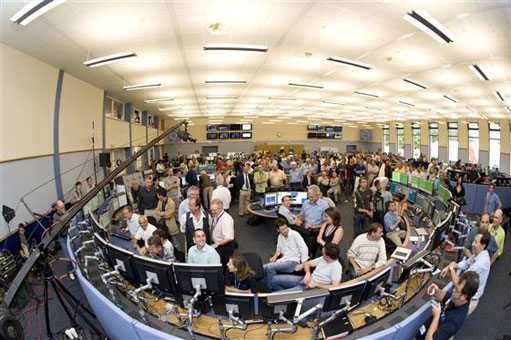
ATLAS e-News
23 February 2011
First beam day
15 September 2008

Journalists in the Globe watch the live broadcast from the Control Centre
The room at the top of the Globe was tense and quiet as a room packed with journalists can be, at 9:30 the morning of Wednesday, September 10th. All eyes watched a dark screen in the CERN Control Centre, the beam-pipe a vague bluish funnel in the upper left corner of the projector screen. Then, a flash of light! Applause from the folks on the screen and the journalists in the room followed. That was the first injection.
A few minutes later, the LHC physicists and engineers sent a bunch of protons through the first section. On the blue screen, a patch suddenly glowed white – the beam of protons passing through a thin, fluorescent film at point 3.
Meanwhile, in the ATLAS Control Room, our shifters and first beam attendees were tracking the progress of the beam, not by webcast but by e-logbook (viewable by those on CERN networks). While the webcast was shown in the room above, where ATLAS physicists in Melbourne, Australia met with their counterparts at CERN via satellite, those in the control room had no visuals of the activity in the CCC.
The ATLAS staff handling the journalists was mostly able to keep them upstairs during the technical work. However, a couple of TV crews were stationed in the control room, behind the red and white tape, with cameras gazing out over the stations where collaborators monitored their sub-detectors for beam-related activity.
ATLAS hosted five TV crews that hadn’t pre-registered with the CERN Press Office – from Romania, Germany, Spain, Italy, and the United Kingdom. Over 100 journalists came by to check out the action. “Today, the word here was ‘improvisation’,” said a grinning Helfried Burckhart, in charge of the media activity at ATLAS.
Just before the beam went through Point 7, someone thought to turn on the radio so that we could hear the broadcast in real time. When a bunch of protons finally made the first full circuit, at 10:26 according to the log book, we heard the clapping and whoops of the beam technicians in the CCC, accompanied by applause from our own Control Room. It wasn’t until a few minutes later that yellow and green streaks of particle tracks adorned the projected image of the ATLAS detector, causing the room to erupt in cheers and enthusiastic applause from at least 130 hands.
“It’s great that we saw something,” said Sotiris Vlachos, run coordinator for the muon system.
Helfried compared the first event in ATLAS to watching the detector come to life, saying: “It starts breathing, so to speak.”
Champagne wasn’t allowed in the Control Room itself, but toasts followed on the first floor, and the sparkling beverage was delivered to outpost buildings of Point 1 by a smiling Connie Potter, of the Secretariat. Even the journalists got in on the celebration before “invading” the Control Room, as Helfried described it.
Fabiola Gianotti, on her way from the Globe to the Control Room just after the first beam circulation, was all smiles as well. “It’s been so fast!” she marveled. “It could have taken hours.”
Lyn Evans, head of the accelerator project, probably said it best when he credited all the hard work that had gone into making the start-up a success: “It might have looked easy to you, but it was only easy due to the quality of the equipment, the quality of the software, and the quality of the people operating the LHC.”

The crowded CERN Control Centre
In the afternoon, the beam physicists successfully circulated a bunch of protons in the opposite direction, starting at 2 p.m. and finishing just after 3 p.m. By this time, journalists were already disappearing to write up and submit their stories before they became old news.
The day concluded with an invitation for all on the ATLAS email list to partake in the last of the champagne and a 3D ATLAS film on the first floor, above the Control Room at Point 1. At least 80 collaborators squeezed into the warm room and donned polarized glasses to watch some highlights from the building of the detector, looking back on the path to this moment.
Marking the end of construction and the beginning of operation, that first beam event in the detector offers a chance to recall the many achievements behind this collaboration and look forward to the discoveries on the road ahead.

Katie McAlpineATLAS e-News
|